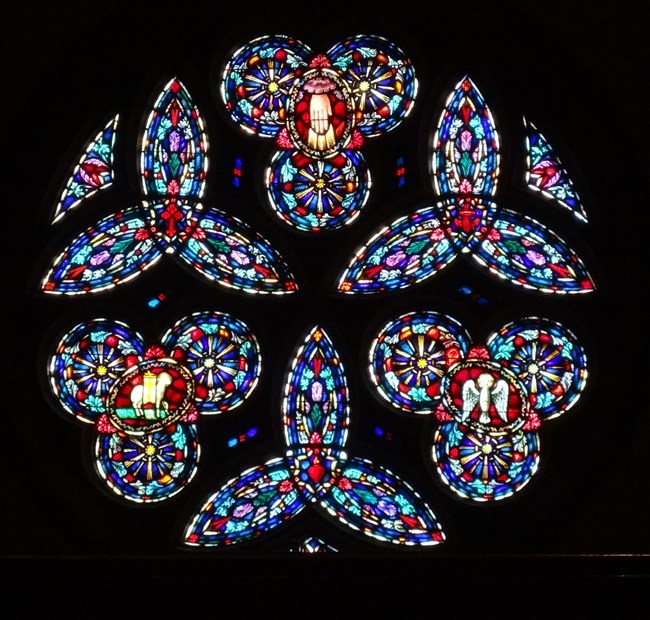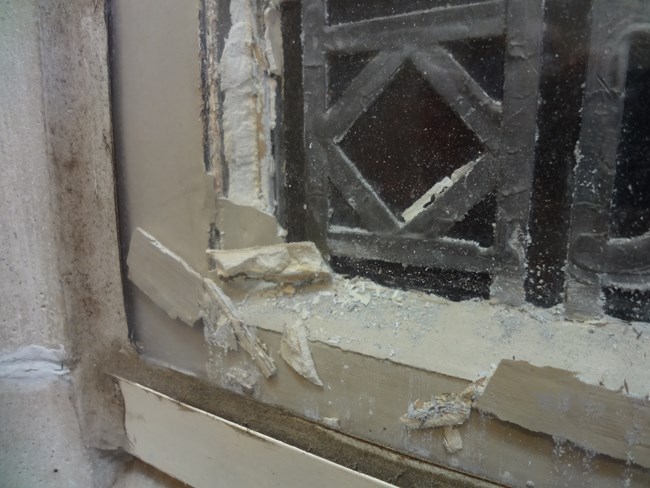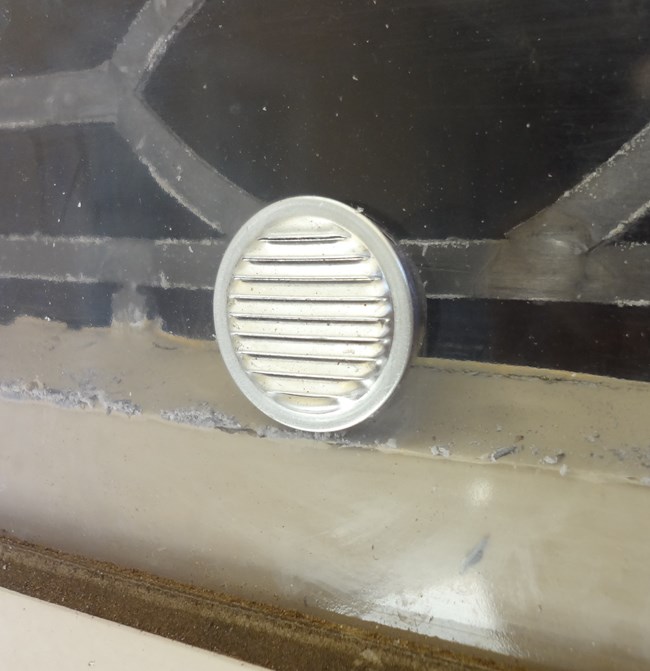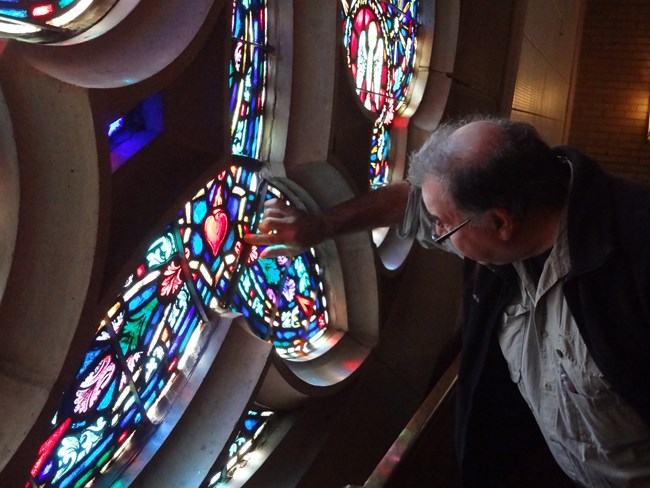Last updated: April 7, 2025
Article
Podcast 077: Issues with Hot Air: Venting Historic Stained Glass Windows

Botti Studio
Vented vs. Unvented
Jason Church: Now Mike we are here at Emmanuel Baptist Church in Alexandria Louisiana where Botti Studio is doing a lot of work on the stained glass windows in the sanctuary. Exactly what is the crew out there doing today?
Michael Smoucha: Well today they are installing vents to existing protective glazing which was put in a few years ago unvented.
Jason Church: What is the advantage of doing venting?
Michael Smoucha: Well what the venting does is two fold. One is it allows the temperature, which can actually build up quite a bit in this space and the inter-space between the stained glass and the protective glazing. It allows that temperature to equalize with ambient temperatures and actually by putting vents at the top and the bottom of each opening it allows convection. The cooler air will come in from the bottom, warm air will rise and flush out at the top. It also allows escaping of built up moisture. The moisture can either be in the form of actual water that gets in or more commonly water vapor.
Jason Church: Now how much temperature difference do you expect to see between the vented and the unvented?
Michael Smoucha: Well the unvented windows can get pretty hot. Basically the space in between those two are certainly not hermetically sealed so it’s not like a thermal unit where you have temperature controlled airspace between two layers of glass. So that space can actually heat up considerably.
Jason Church: What is the danger with it heating up against the stained glass?

Botti Studio
Temperature-Related Damage
Michael Smoucha: The dangers are two fold. One of them is the heat can accelerate the drying out of the putty that is internal to the lead comes which wrap around each of the pieces of glass. It can also accelerate the aging and drying out of the lead itself. The water vapor that gets trapped and heated up inside the space can cause damage both to the lead came matrix as well as to the glass and also again to the putty or the calcium carbon that is around the pieces of glass. Often times we notice that on the windows here there was calcium blooming on the exterior of the windows we actually see calcium leaching out of the putty and blooming over the lead and even onto the glass. All of those can have a detrimental affect to the glass and the lead.
Jason Church: I know historically we didn’t have a lot of glazing when did that come about?
Protective Glazing & UV
Michael Smoucha: Protective glazing came about probably – I started seeing it a lot more in the 60’s. Currently with protective glazing there’s a lot of pro’s and con’s to putting protective glazing up. A lot of authorities say not to do it at all. Some places are more prone to wind and hurricane damage or to vandalism or other types of damage. In those cases if protective glazing is decided upon to be put up it just has to be put up and properly vented. Again the venting is a critical part of that and without it you certainly are potentially causing more problems.
Jason Church: Are there some materials that are better than others for glazing itself?
Michael Smoucha: We often prefer when protective glazing is called for to use a laminated safety glazing. A couple reasons for that is it is a safety glass so if anything happens to the glass it does stay together. Secondly there is an added benefit of the UV inner layer actually acting as a UV barrier. It filters out about 99% of UV. So it effectively helps to protect again the glass to a certain degree the lead and the interior spaces too where UV can damage.

Botti Studio
Conservation & System Design
Jason Church: I know here the church you are working on I’ve walked around and seen. You are installing vents in the top and the bottom to allow the convection of air like you were talking about. Is there any advantage if you have a yellowed – if your glazing has yellowed or frosted with time is there a real need to replace that or is there an advantage to replacing that?
Michael Smoucha: There are advantages and certainly the work being done at Emmanuel is meant to and has always has been meant to be an interim solution to prevent ongoing damage from getting worse with the goal to eventually remove this particularly glazing. Either leave the windows as they were historically or if the church decides to put protective glazing to put it an alternate glazing on there. As you mentioned some of the draw backs to the Lexan glazing are that they do yellow and they do discolor. Secondly they also have more deflection than glass would.
Jason Church: Now is this the type of work Botti Studios does a lot? Tell us about the type of work you guys do.
Michael Smoucha: This is one of the facets of work that we do. We perform conservation/restoration to the stained glass and of course to the system. That system includes the protective glazing if there is any to the frame system, all the architectural elements in that frame system. We also fabricate and design new work. Both in stained glass and mosaics, murals, statuary, painting and decorating. We are a full range architectural arts firm that also includes a lot of the architectural elements in those art pieces.
Jason Church: Basically anything involved with the stained glass windows. I know you do some masonry. You are doing some masonry here on the big cast stone, Rose window here but the glass, the system the whole.

Botti Studio
Michael Smoucha: Right. The ceiling system, the frame system, restoration of all of the frame elements be they stone, wood, metal and everything in between. We are currently working on St. Patrick’s Cathedral in New York City as a matter of fact doing work very similar to work that is going on here. Actually the work is more involved. We are actually replacing a lot of the protective glazing as well as working on the conservation/restoration of the windows themselves.
Jason Church: Now you mentioned earlier we saw some calcium blooms on the lead in some of the windows that glazing wasn’t vented. What would you recommend for that? Does that need to come off? Does it need to be cleaned?
Michael Smoucha: We remove them in the restoration process. A full restoration of the windows of course would include removal; disassembly, releading and all of that corrosion will be removed at that time. In the interim solution it would be removed by conservation cleaning of the windows in situ. Depending on the other conditions of the window as well as the church needs and budgets at the time. Work is scheduled accordingly.
Jason Church: I know with religious institutions I’m sure you have to work with a very wide range of budgets and really work with them to meet their needs.
Michael Smoucha: Right. Right. And to keep the pieces as safe and secure as they can be within the budgetary constraints.
Jason Church: Well Mike, Thank you so much for talking to us today. We look forward to hearing from you in the future with more work that you are doing.
Michael Smoucha: Thank you.
